Content
- India’s UPI Revolution
- PM Dhan-Dhaanya Krishi Yojana
India’s UPI Revolution
What is UPI?
- Unified Payments Interface (UPI) launched in 2016 by the National Payments Corporation of India (NPCI).
- Integrates multiple bank accounts into a single mobile interface.
- Enables instant fund transfers, merchant payments, utility bill payments, and peer-to-peer transfers.
- Designed as an open, real-time, low-cost and interoperable system accessible to all.
Relevance : GS 3(Economy -Banking , Digital Infrastructure)

India: Global Leader in Fast Payments
- As per IMF’s July 2025 report, India is the world’s foremost country in fast digital payments.
- India accounts for nearly 50 percent of global real-time payment transactions.
- UPI has overtaken global giants like Visa in daily transaction volume:
- UPI: 640+ million transactions per day.
- Visa: 639 million transactions per day.
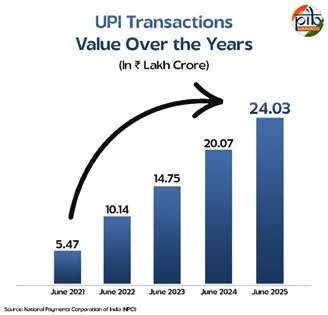
UPI in Figures (June 2025)
- Total Transactions: 18.39 billion (32 percent YoY growth).
- Transaction Value: ₹24.03 lakh crore.
- Share in India’s digital transactions: 85 percent.
- Share in global real-time digital transactions: nearly 50 percent.
- Number of users: 491 million individuals.
- Number of merchants onboarded: 65 million.
- Number of integrated banks: 675.
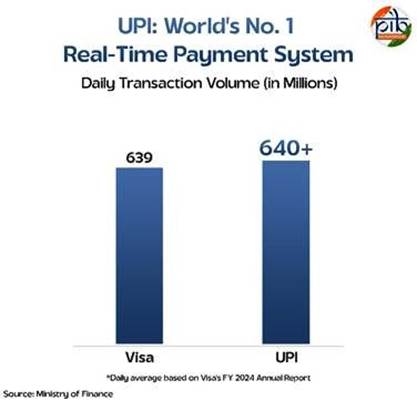
UPI’s Global Expansion
- UPI is live in seven countries: UAE, Singapore, Bhutan, Nepal, Sri Lanka, France, Mauritius.
- France marks UPI’s entry into Europe, enabling seamless transactions for Indian travelers.
- India is pushing for UPI standardization within the expanded BRICS bloc to enhance cross-border remittances and financial inclusion.
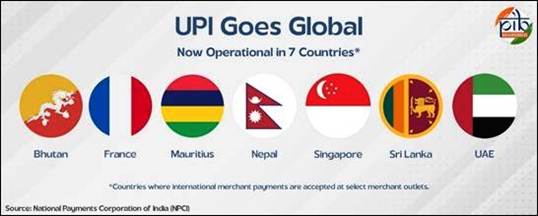
UPI and Interoperability
- UPI introduced true interoperability in digital payments—users can transact across different apps and banks.
- Pre-UPI systems were closed-loop (e.g., limited to a single wallet or bank).
- UPI’s open architecture allowed third–party apps (like PhonePe, Google Pay, Paytm) to thrive on a common backbone.
- Benefits of interoperability:
- Freedom of choice for users.
- Competitive innovation among service providers.
- Seamless, frictionless experience.
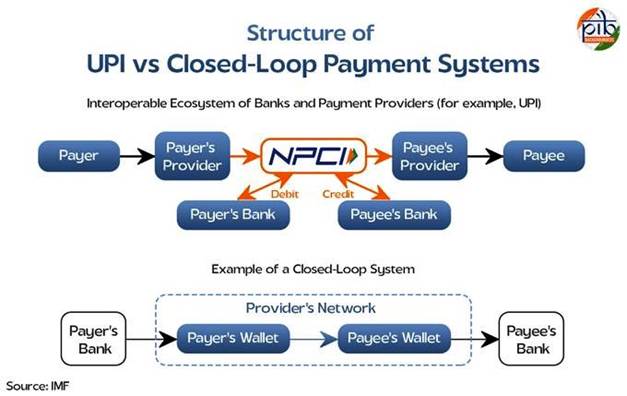
Impact on Daily Life
- Instant 24×7 payments from mobile phones—no need for cash or bank visits.
- One app can manage multiple bank accounts.
- Payments secured via two-factor authentication without disclosing sensitive details.
- UPI ID ensures privacy, reducing data vulnerability.
- QR code-based payments at street vendors, kirana stores, delivery points.
- Replaces cash-on-delivery hassles in online commerce.
- Utility bills, donations, mobile recharges—all accessible via one platform.
- In-app grievance redressal mechanisms offer faster resolution.
Foundational Drivers of UPI’s Success
1. Jan Dhan Yojana
- Launched in 2014 to promote financial inclusion.
- As of July 2025, 55.83 crore accounts opened.
- Enabled direct benefit transfers (DBTs) and formal savings.
2. Aadhaar and Digital Identity
- Aadhaar offers biometric-based unique identification.
- Over 142 crore Aadhaar cards issued by June 2025.
- Integral for KYC, subsidy delivery, and authentication for UPI accounts.
3. Connectivity and Digital Infrastructure
- Rapid 5G rollout with 4.74 lakh base stations (2025).
- Mobile subscriber base reached 116 crore.
- Drastic fall in data cost from ₹308/GB (2014) to ₹9.34/GB (2022).
- Affordable smartphones and internet access catalyzed digital adoption.
Why UPI is a Global Model
- Developed as a part of India’s public digital infrastructure (India Stack).
- Open-source, scalable, and innovation-friendly.
- Contrasts with private-dominated payment systems in the West.
- Demonstrates how state-led digital architecture can enable inclusion, competition, and efficiency.
Conclusion
- UPI has transformed India from a cash-heavy to a digital-first economy within a decade.
- It is not merely a payment tool but a model of digital public good.
- Built on financial inclusion (Jan Dhan), identity (Aadhaar), and connectivity (mobile+data).
- Its global expansion signifies India’s emergence as a leader in fintech diplomacy.
- UPI has set the global standard for secure, real-time, inclusive digital payment systems.
PM Dhan-Dhaanya Krishi Yojana
Overview
- Approved: 16 July 2025 by Union Cabinet
- Duration: FY 2025–26 to FY 2030–31 (6 years)
- Annual Outlay: ₹24,000 crore
- Coverage: 100 low-performing agri-districts
- Target Beneficiaries: 1.7 crore farmers
- Nature: Not a new scheme, but convergence of existing 36 Central schemes across 11 Ministries, supplemented by State schemes and private partnerships.
Relevance : GS 3(Agriculture ),GS 2(Schemes)
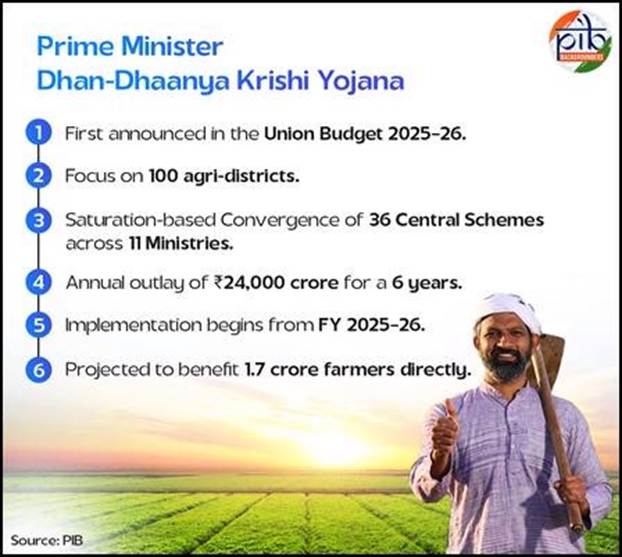
Objectives
- Increase agricultural productivity through targeted interventions.
- Promote crop diversification and sustainable practices.
- Expand irrigation infrastructure to improve water security.
- Enhance storage capacities at the panchayat/block level.
- Facilitate access to credit, both short and long-term, for farmers.
District Selection Criteria
- Parameters: Low productivity, low cropping intensity, weak agri-credit disbursement.
- Geographic Equity: Minimum one district per state/UT.
- Proportional Distribution: Based on share in Net Cropped Area and operational holdings.
Design and Governance Framework
- District-Level Implementation
- District Dhan-Dhaanya Krishi Yojana (DDKY) Samiti chaired by District Collector.
- Involves progressive farmers, agriculture officers, panchayats, and local stakeholders.
- Each district to prepare a District Agriculture & Allied Activities Plan, guided by:
- Agro-ecological conditions
- Local cropping patterns
- Sustainability priorities (e.g., organic farming, soil health, water use)
Three-Tier Institutional Structure
| Level | Role & Mechanism |
| District | DDKY Samitis for planning and coordination |
| State | State Steering Committees for inter-departmental synergy |
| National | Oversight teams under Union Ministers and Secretaries |
- Central Nodal Officers: Assigned to each district for field monitoring and feedback.
Knowledge and Technical Support
- NITI Aayog:
- Capacity building
- Performance tracking
- Strategic guidance
- Digital dashboard oversight
- Agricultural Universities:
- Technical support for district plans
- Farmer advisories and extension services
- Research-backed interventions
Digital Infrastructure and Monitoring
- Mobile App for farmers:
- Multilingual
- Crop advisory, scheme details, grievance redressal
- Monitoring Dashboard:
- Tracks 117 Key Performance Indicators (KPIs)
- Provides real-time updates to Centre, States, and Districts
- District Ranking System:
- Encourages competitive federalism
- Rewards timely, efficient, inclusive implementation
Convergence Model: A Replicable Strategy
- Inspired by Aspirational District Programme (ADP) model of targeted, data-driven convergence.
- Leverages existing schemes like:
- PM-KISAN, PMFBY, e-NAM, ATMA, RKVY, PMKSY, etc.
- Avoids fragmentation, reduces overlap, and enhances impact at the ground level.
Focus Areas (Beyond Traditional Cropping)
- Fruits, vegetables, and horticulture
- Fisheries and aquaculture
- Beekeeping and honey clusters
- Animal husbandry and dairy
- Agroforestry and natural farming
Expected Outcomes
- Improved yield and productivity across targeted regions.
- Enhanced local value chains and agri-processing opportunities.
- Resilient and climate-smart farming systems.
- Higher income and job creation in rural economy.
- Increased domestic agri-output, supporting Atmanirbhar Bharat.
Timeline and Next Steps
- July 2025: Districts and nodal officers finalized.
- August 2025: Training and onboarding of implementing teams.
- October 2025 (Rabi Season): Ground rollout of district plans and convergence activities.
Conclusion
The PM Dhan-Dhaanya Krishi Yojana represents a bold systemic reform to revitalise Indian agriculture in lagging districts. With its emphasis on convergence, decentralised planning, institutional partnerships, and real-time monitoring, it has the potential to drive a second Green Revolution—this time led by equity, efficiency, and ecological sustainability.
It is a clear step toward fulfilling the vision of “Sabka Saath, Sabka Vikas” in the agricultural sector, and bridging regional disparities in rural prosperity.



